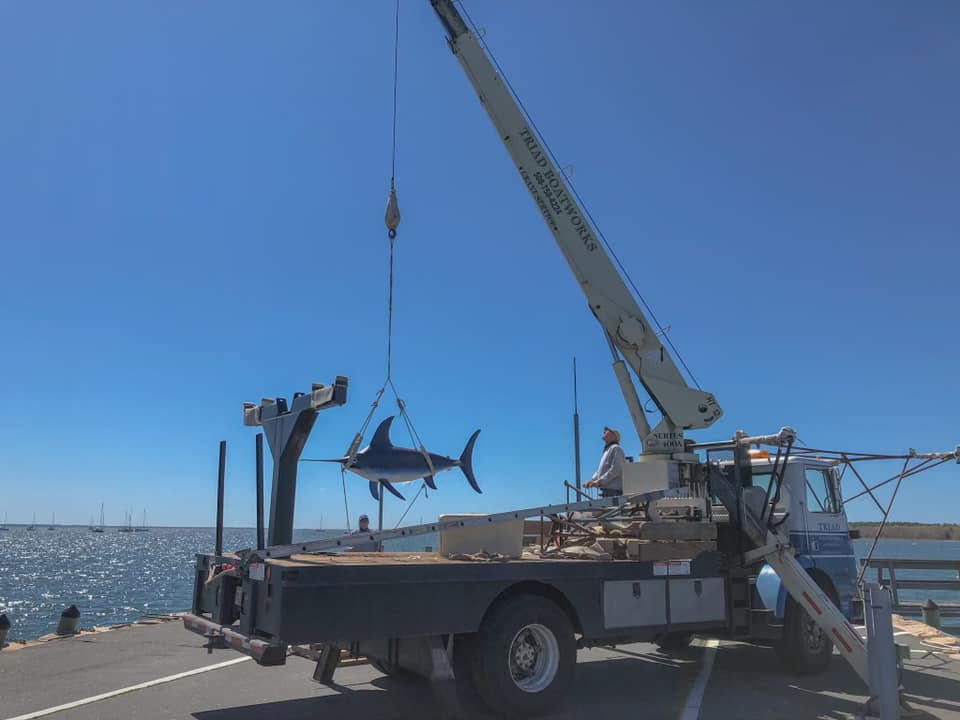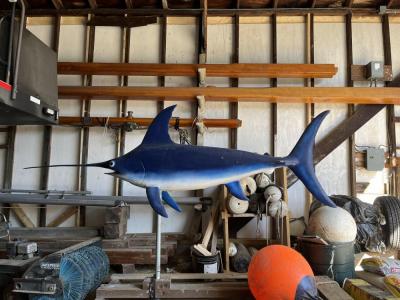Vintage swordfish weathervane may get new life
MATTAPOISETT — At the start of every summer at Long Wharf, Mattapoisett’s swordfish weathervane goes up and starts spinning, a sure sign that the fishing season is in full swing.
But the years have taken their toll, and the swordfish can no longer withstand the elements.
Mattapoisett’s Community Preservation Committee voted at its Friday, March 4 meeting to build a new replica of the weathervane, and to restore the old one in order to display it at the Mattapoisett Museum.
The swordfish weathervane “has real significance, particularly to the people that use the harbor and the wharf,” said Chuck McCullough, chair of the Community Preservation Committee. “I believe it’s as significant as the seahorse.’’
This work will have to be approved by voters at Town Meeting in May.
The repairs will cost $12,500 and be paid for by the Community Preservation Act. This act, which was approved by town voters, allows Mattapoisett to place 1% of all tax revenue on properties over $100,000 into a community fund. One of the things that money can be used for is historical preservation.
The replica itself will be made of fiberglass or another material that is able to withstand the elements. When that’s done, the committee plans to send the original to the Mattapoisett Museum.
“The existing one can never go up again,” said McCullough when explaining the need for the replica.
“It’s in such bad shape because it’s been repaired so many times,” said committee member Margaret DeMello, commenting on how the swordfish has been repaired with improvised approaches in the past.
The current weathervane is 16 feet-long from point to tail and is made of wood, metal, and fiberglass to balance it properly. “It’s the source of a lot of nostalgia and history in this town,” McCullough said.
The weathervane has been preserved so far due to the hard work of a handful of residents who have donated their own time and labor to take care of it. One of these residents is Bill Field, a descendent of the family that donated the weathervane to the town.
The swordfish went up on the Hinsdale property of F. Gilbert Hinsdale, Field’s great uncle, in what Field guesses was probably the 1920s.
Field was born in 1937, and the swordfish was taken down a year later because of the Hurricane of 1938.
“The same thing happened again with the hurricane in 1944,” Field said. “So, they took it down again and stored it until the 50s, when my great aunt, Patricia Hinsdale, donated it to the town.”
It’s been going up every summer at Long Wharf since.
The weathervane itself was built by a craftsman named Manuel Perry. “The dimensions of the weathervane were taken from a real swordfish that was brought into town,” said Field. He explained that in the story he was told by his family, the weathervane didn’t work when it was first put up.
“Because it was based on a real swordfish, it wasn’t aerodynamically correct for wind, so they had to remove it.” As a result, they had to take the sides and plane them down until they were flat. After those repairs, it worked.
No one took a good close-up look at it again until the 1970s, when Field and other community members took it back down to do some major renovations.
“It had been saturated with water from the inside out and it was collapsing,” he said. Every year since then, Field has been part of the group to take it down and repaint it.
Triad Boatworks has taken responsibility for storing and preserving it each year.
Field shared another piece of history that residents may not know: The swordfish is not empty.
There are three time capsules inside the weathervane. One has F. Gilbert Hinsdale’s writing in it, another is from the Brownell Boatyard, and the third was placed there by Field and his colleagues. He recommended the time capsules be displayed in the museum.
“It’s an iconic fixture of the town and it’s got a lot of history to it,” he said.

















